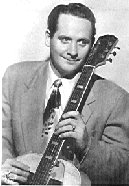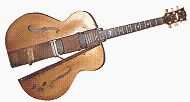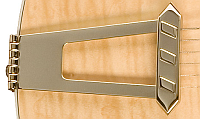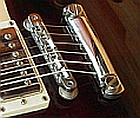Les Paul Guitars...
True Icons
Les Paul

Gibson's Les Paul guitars are arguably the most well known and most coveted electric
guitars ever made. Since the release of the first Les Paul model in 1952, the Gibson
Les Paul has been a favorite of guitarists from all styles. Ironically, Les Paul, the namesake
of the guitar had approached Gibson in 1945 with an idea for a solid body electric guitar and had been
turned away.
The Log

Paul's original guitar, dubbed "the Log" was basically a a 4x4 piece of pine fitted with two pickups.
Gibson didn't like the way it looked, calling it a "broomstick with pickups". In addition, previous
attempts at marketing solid bodied electric guitars had not been successful and Gibson didn't think
the market would accept another any more than it had previously. Even though Les had proven that his
guitar not only worked well and solved the resonance problems inherent in a hollow-bodied electric guitar,
Gibson was unswayed.
A Change of Heart...
In my mind, the man who was really responsible for the development of the Les Paul guitar was actually Leo Fender.
In 1943, Fender built a prototype solid body electric guitar. After refinements, Fender released it 1949 as the Esquire.
Later renamed the Telecaster, it proved to be very popular. Seeing Fender's success with it Gibson's president,
Ted McCarty, decided that the solid bodied electric guitar's time had come. The Les Paul electric guitar was about
to be born.
In 1951, McCarty approached Les Paul about a collaboration on a new solid body electric guitar. Les most likely felt a bit
smug about this because of the earlier rejection. It isn't entirely clear how much actual input Les had on the guitar's
design. According to McCarty, he and his design team had already designed the guitar before approaching Les for his endorsement.
Their story has Paul's only contributions being the trapeze bridge/tailpiece and his name on the guitar.
According to Les, he already had the Gold Top standard and black Custom in mind when McCarty approached him. In addition(according to Les),
they implemented his tailpiece incorrectly. Les also claimed that Gibson gave him the final say on every aspect of the guitar's design.
Muddying the waters even further, Les claimed that he was displeased that both the Custom and the Gold Top had a mahogany and a maple
top. Les claimed that he had intended that the Gold Top was supposed to be solid mahogany. Regardless as to where the truth actually
lies, the the mahogany/maple combination proved to be a winner and was released in 1952.
Bridge Design Modifications...
The Trapeze Bridge

The trapeze bridge/tailpiece was not the greatest design in the world. It had some major flaws. One, if the tailpiece was knocked or banged the
guitar would go out of tune. Two, the strings went under the bridge instead of over it. Both these problems made palm muting, a common playing
technique, impossible. Les claimed that he had specified that the strings go over the bridge and that the neck be slanted to accomodate
this. Gibson insisted that the neck join could not be changed and that the wrap-under design had to stay. The final problem was that the design
made adjusting the intonation impossible.
Wraparound Bridge

In 1953, the trapeze bridge was replaced with a wrap-around bridge. The wrap-around bridge is a simple design and povides a strong anchor
point that contributes great sustain and a warm, full tone. The strong anchor point also increases tuning stability. The top of the bar has
a gentle curve to it which provides a round and somewhat fuzzy tone which many players really like. The wrap-around bridge was used on Les
Paul guitars from 1953-1955. Despite its advantages over the trapeze bridge it shared a major flaw. There was still no way that you could adjust
the intonation.
Tune-O-Matic Bridge with Stopbar Tailpiece

In 1954 the wrap-around bridge was replaced by the Tune-O-Matic bridge with stopbar tailpiece(designed by McCarty himself). The tune-o-matic
allowed individual intonation adjustment for each string. The tune-o-matic was originally used on the Les Paul Custom, also released in 1954.
In 1955, the Gold Top also got the tune-o-matic. Since that time the most popular Les Paul guitars have been fitted with tune-o-matics.
Les Paul Vibrato Tailpieces...
Bigsby B7 Tailpiece

Les Paul guitars typically use a tremolo design that sits on top of the body of the guitar rather than being fitted into the body like
the tremolos on Fender or Ibanez guitars. From late 1955 onward around 10% of the Les Pauls were fitted with the Bigsby B7 vibrato rather
than the stop tailpiece. The Bigsby vibrato unit is installed on the top of the guitar and works in conjunction with a rocker bridge. The arm of the Bigsby is spring
loaded and attached to a pivoting metal bar, around which the strings of the guitar are installed. In the neutral or unused position,
the pressure of the spring counterbalances the pull of the strings, resulting in constant pitch when the strings are played.
When the arm of the Bigsby is pushed down towards the top of the guitar, the bridge rocks forward causing the strings to loosen, lowering
their pitch. When the arm is released, the strings return to normal pitch. The arm may also be lifted slightly to raise the pitch of the
strings. The B7 is a rather clunky design and doesn't work quite as well as the tremolo systems used by other manufacturers. Using it for
Steve Vai style whammy bar pyrotechnics won't work. Not only are you going to knock the strings out of tune, if you lift the bar too high the
spring will fall out. It's best used for slow and subtle bends.













New! Comments
Have your say about what you just read! Leave me a comment in the box below.